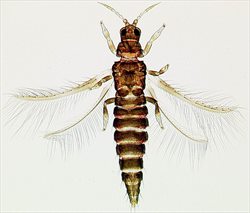
Female
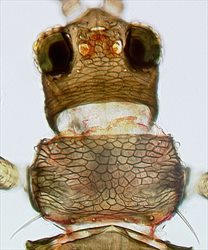
Head & pronotum

Antenna

Maxillary palps
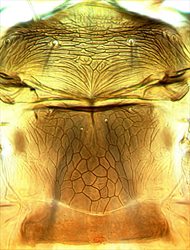
Meso & metanota
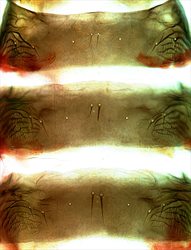
Tergites
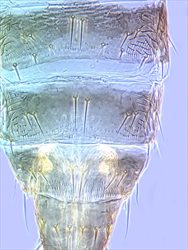
Tergites VI-IX
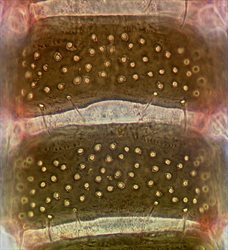
Male sternites
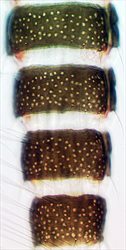
Male sternites

Fore wing
Both sexes fully winged. Body brown with red internal pigment; tarsi and apices of tibiae yellow, also antennal segments III–IV; fore wings brown but sharply white near base. Antennae 8-segmented, segments III–IV with curved simple sensorium. Head with complex reticulate sculpture; three pairs of ocellar setae present, pair III anterolateral to ocellar triangle; inner margin of eyes with two pairs of stout postocular setae.Pronotum strongly reticulate, with two pairs of prominent posteroangular setae. Metanotum reticulate; median setae small, arising near anterior margin. Fore wing pointed, curving forward; first and costal veins with long capitate setae, second vein without setae. Abdominal tergites II–VIII with median paired setae long and close together; tergite lateral thirds with irregular rows of prominent microtrichia; VIII posteromarginal comb of microtrichia complete. Sternites with marginal setae arising in front of margin.
Male similar to female; sternites III–VIII each with up to 100 small circular pore plates.
The genus Echinothrips includes only eight species, all of which are found between eastern North America and southern South America (Mound & Marullo, 1996), but with E. americanus an invasive horticultural pest in other parts of the world. The genus appears to show relationships to the genera of Sericothripinae (Lima & Mound, 2016).
Feeding and breeding under glass on the leaves, but also visiting flowers, of several Araceae, including Dieffenbachia, Philodendron and Syngonium, but also from other plants, usually with hard leaves, including Hibiscus [Malvaceae]. This species is also recorded as a pest on crops of Capsicum [Solanaceae].
First recorded from Britain in a butterfly house in 1989, it has been regarded as established under glass since numerous findings were made in commercial glasshouses during 1995 (Collins, 1998), and it is still regularly encountered, particularly in heated houses. It is known from the Republic of Ireland (Dunne & O’Connor, 1997) and is also established in European greenhouses from Sweden to Italy and Bulgaria (Vierbergen et al., 2006). The horticultural trade in live plants has transported this species widely around the world, and it has been recorded in Java and in northern Australia.
THRIPIDAE - THRIPINAE
Echinothrips americanus Morgan
Echinothrips americanus Morgan, 1913: 14
Dictyothrips floridensis Watson, 1919: 2
Collins DW (1998) Recent interceptions of Echinothrips americanus Morgan (Thysanoptera: Thripidae) imported into England. Entomologist’s Monthly Magazine 134: 1–3.
Dunne R & O’Connor JP (1997) Echinothrips americanus (Thysanoptera: Thripidae) new to Ireland. Irish Naturalists’ Journal 25 (11/12): 412–413.
Lima EFB & Mound LA (2016) Systematic relationships of the Thripidae subfamily Sericothripinae (Insecta: Thysanoptera) Zoologischer Anzeiger 263: 24–32.
Mound LA & Marullo R (1996) The thrips of Central and South America: an introduction. Memoirs on Entomology, International 6: 1–488.
Vierbergen G, Cean M, Szellér IH, Jensor G, Masten T & Simala M (2006) Spread of two thrips pests in Europe: Echinothrips americanus and Microcephalothrips abdominalis (Thysanoptera: Thripidae). Acta Phytopathologica et Entomologica Hungarica 41: 287–296.